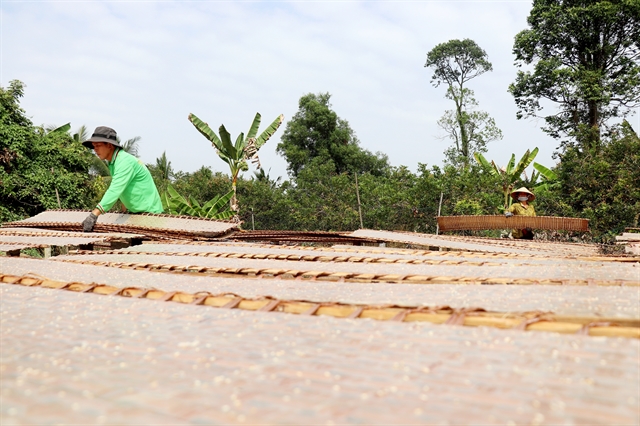Cần Thơ advances rural occupations, craft villages
The Cần Thơ People’s Committee has outlined a plan to develop rural occupations and craft villages until 2030, with a vision extending to 2045, aimed at enhancing rural livelihoods and preserving traditional craft villages.
 |
| Workers dry rice paper under the sun in Thuận Hưng rice paper making village in Cần Thơ City’s Thốt Nốt District. – VNA/VNS Photo Thu Hiền |
CẦN THƠ – The Cần Thơ People’s Committee has outlined a plan to develop rural occupations and craft villages until 2030, with a vision extending to 2045, aimed at enhancing rural livelihoods and preserving traditional craft villages.
The plan seeks to support the development of rural occupations and craft villages to preserve and promote the values and potential of rural areas, as well as the traditional identities of craft villages.
It aims to enhance the production efficiency of craft villages, improve the competitiveness and added value of their products, create more job opportunities, and enhance the lives of rural residents.
Additionally, it aims to protect the environment in rural areas, fostering their development alongside ecological and modern agricultural practices and promoting smart farming.
According to the plan, the Cửu Long (Mekong) Delta city will preserve and develop four traditional craft villages, while developing one to two craft villages in conjunction with offering rural tourism services and constructing new-style rural areas by 2030.
The plan targets the effective operation of over 80 per cent of traditional craft villages, with all workers trained in vocational skills, occupational safety and health, and basic information technology knowledge.
It also aims for at least 50 per cent of traditional craft villages having a brand name for their products by 2030.
The plan outlines production growth of 10 per cent a year for traditional craft villages, with all their establishments and households meeting environmental regulations by 2030.
Rural occupations are targeted to achieve a growth rate of 6-7 per cent annually, with the average income of rural workers in 2030 projected to be 2.5-3 times higher than in 2020.
The plan also aims for 80 per cent of rural workers possessing vocational skills by 2030, with 35 per cent holding vocational skill certificates.
By 2030 the city plans to establish concentrated raw material areas to meet 70 per cent of the demand for them.
With over 114,000 hectares of farmlands, accounting for 79 per cent of its total area, it wants rural occupations to continue generating incomes and jobs for locals by 2045.
The city plans to develop rural occupations and craft villages in a sustainable, smart and environmentally-friendly manner in conjunction with building green, clean and beautiful rural areas.
To achieve these goals, its People’s Committee will intensify advocacy efforts to raise awareness among Party members and the public about the plan, promote the roles of artisans and outstanding workers and preserve and develop traditional craft villages.
Investment in production infrastructure, mobilisation of loans for rural occupations and increased transfer of technology for production are among the proposed initiatives.
The city also intends to provide financial support for human resource training, participation in the national “One Commune - One Product” programme, environmental protection, production development coupled with tourism services, concentrated raw material area development, trade promotion, and industrial extension activities.
The city currently has 12 craft villages, including the Thuận Hưng rice paper village and Thơm Rơm net weaving village in Thốt Nốt District, and the Phó Thọ - Bà Hộ flower village in Bình Thuỷ District.
Thuận Hưng was also recognised as a national intangible cultural heritage site last year. – VNS
